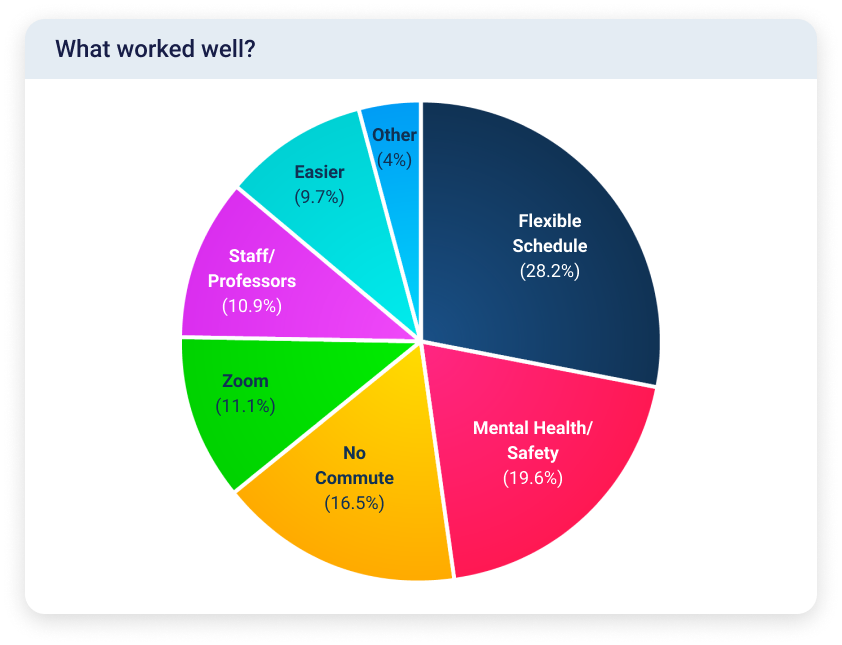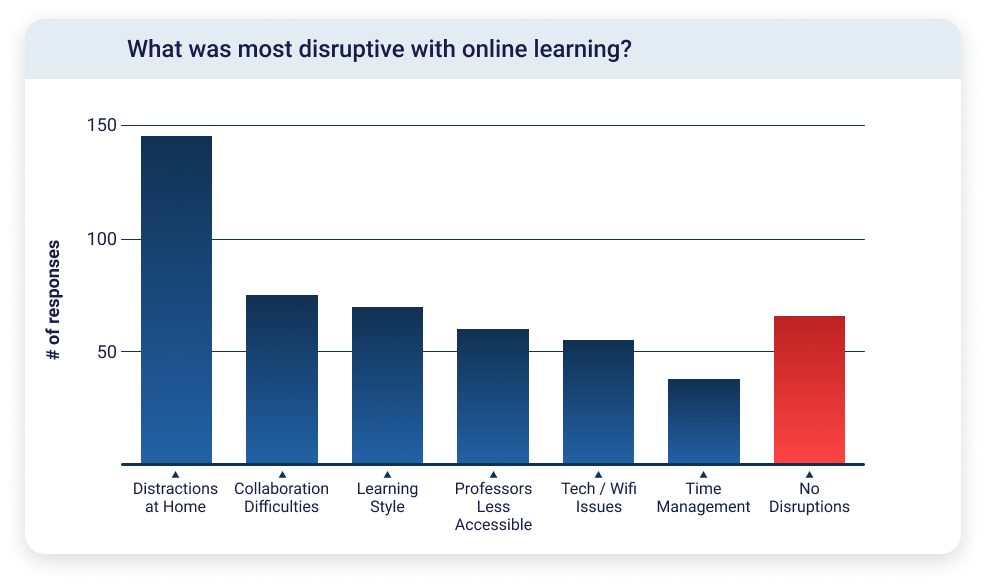College in the COVID Era: Students Share What Went Well and How Schools Can Do Better
Surveys conducted early in the pandemic show students were not happy with the quality of education when classes initially moved online due to COVID-19. Since then, schools have worked to improve online programs by training faculty and adapting curriculums. Now that spring quarter has ended and fall classes are underway, we wanted to hear from students about their overall experience with online learning.

We conducted a survey in August and early September to find out how the shift to online learning affected students, and how schools could alter their approaches. We received responses through SurveyMonkey from 496 current college students across degree levels, subjects, and age groups.
Respondents were enrolled at 387 universities, community colleges, and technical schools across the country, including Duke University, University of Florida, University of Southern California, Yale University, Texas A&M, and Johns Hopkins University. As start dates for fall quarter varied, some responses reflected experiences in online classes for both fall and spring while others were focused only on spring quarter.
Key Findings
- Now that they’ve tried online classes, 50% of students say they’re more likely to pursue it in the future (and 33% are less likely)
- Students enjoyed the flexibility of online classes, and felt safer and less anxious about COVID-19 with the ability to learn from home
- More than 1 in 4 students said distractions in the home such as family, friends, or pets were the most disruptive aspect of the switch to online learning
- Students need more support – 24% asked for more office hours, and 23% want more communication from schools and professors
- Humanities classes were easiest to learn online, while math and science were most difficult
- At the time of the survey, 55% of students said their schools were fully online for fall quarter, 40% were holding hybrid courses, and 5% had fully in-person courses
Our survey results showed students had mixed feelings about online education, but more than half of students said they were satisfied or very satisfied with their online experience.
This may indicate that efforts to improve online education during spring quarter and in preparation for fall have been successful. It may also suggest that students are adapting to new learning environments.
In a recent article, we heard from four new graduates who just joined our team at Optimal. They spoke more in-depth on these topics and shared everything from what went well in the switch to online to advice on looking for a job during a pandemic.
More information on higher education during COVID-19, including online programs, taking a gap year, financial aid, and the job market can be found on our COVID-19 FAQs and Resources page.
What did students like about online learning?
Students most frequently said they enjoyed the added flexibility that comes with online learning. Three in ten students (28%) cited the convenience of attending class online as something that worked well in the transition. Students said recorded lectures allowed them to take classes on their own schedule, at their own pace.
This is one of the biggest draws of asynchronous learning, where students do not meet with their class at a set time. Some seek out asynchronous online programs to accommodate work, family, or other responsibilities.
“Tailoring classes [around] work hours was a major benefit. Students could go at their own pace while still completing assignments to meet deadlines,” wrote a pre-med student in their junior year at the University of Maryland.

Nearly 20% of students said remote learning helped with their mental health, safety, and comfort during COVID-19. Being able to protect themselves by isolating and learning from home rather than being on campus made students feel safer and reduced anxiety levels.
Online learning also benefited those who lived off-campus – 16.5% of respondents said they had more time in their day because they no longer had to drive, walk, or bus to school.
“Usually, I would spend four hours in total for my commute per day. Now, I don't have to worry about getting ready or waiting for the train,” a senior studying media at Brooklyn College said. “I can be home in sweats and learn online.”
Respondents said remote learning tools as well as staff and instructor support were highlights in their online experience. Advisors, professors, and other school employees worked to support students as best they could during the transition. Zoom, Blackboard, and other online learning tools also made the transition more successful for 11% of respondents.
Faculty adapted to emergency remote classes by changing assignment requirements, canceling or adjusting exams, and switching to pass/fail grades. For some students, online courses were more challenging, but around 10% said classes were easier online.
“Tailoring classes [around] work hours was a major benefit. Students could go at their own pace while still completing assignments to meet deadlines.”
What was most disruptive in the switch to online?
When higher education switched to online learning, many found it difficult to focus, with nearly 30% of students saying they were struggling.
The biggest distractions students mentioned included family and friends, cellphones, and not having a quiet place to study or watch lectures.
Some students struggled because they were also helping their children with virtual learning. Others said being out of the classroom environment made it hard for them to stay engaged.
“At home, there are so many more distractions, and I sometimes find myself wanting to do other things instead of doing online class,” a senior in the nursing program at Concordia University Wisconsin said.

Many students found it challenging to collaborate with peers in group projects or discussions when schools switched to online. A journalism sophomore from Murray State University shared that, as a hands-on learner, the loss of study groups was detrimental to his learning experience.
Other students echoed this sentiment. One respondent, a senior studying creative writing at Wheaton College, said the loss of class conversation made learning more difficult.
“As someone who cannot easily jump into a conversation without raising my hand, it was difficult to insert myself into discussions to participate,” the student said. “It was also hard not having face-to-face interactions. There is a certain feeling in a college classroom that you cannot get online.”
Students also struggled with technical difficulties, Wi-Fi issues, time management, and getting help or talking with professors.
Do certain subjects work better in an online format than others?
Some classes are a natural fit for online delivery, whereas others typically require hands-on experience and are not as easily adapted for remote learning.
We found that 25% of respondents felt humanities classes transitioned best to online. These included classes such as English, foreign languages, writing, history, and theology.
Students said these classes were easiest to move online because they were fact-based and largely required reading and writing, which was easily done from home. They also shared that there were helpful resources available online in these subjects to supplement classroom reading materials.
One-quarter of respondents said math was more difficult online than in-person. Many students said they had a hard time working through math problems and grasping concepts without the visuals and in-person discussions they had in class.
“As someone who cannot easily jump into a conversation without raising my hand, it was difficult to insert myself into discussions to participate. It was also hard not having face-to-face interactions. There is a certain feeling in a college classroom that you cannot get online.”
One respondent said it was hard to get the comprehensive support available in class in the online format.
“Math is hard to learn online because you don't always have the teacher there to answer questions and go over step by step how to work a math problem,” a senior studying marketing at Coastal Carolina University said.
It can be more challenging to get support in part because it’s harder to ask for it in a virtual format. While Zoom does have a “raise a hand” function, it can be awkward to interrupt class in an online setting, especially for students who are new to the format.
As a society, we have had to learn new rules and etiquette for the virtual world. Many are not used to these new communication methods, and studies show it can result in